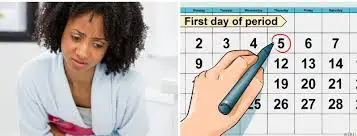
In every woman, the chances of conceiving varies depending on the days of the menstrual cycle. Safe period is the period with the lowest chances of getting pregnant after sex or Intercourse. People that desire to conceive can try tracking their menstrual cycle and planning to have sex around their most fertile days, while knowing the safe period of the month is necessary if you are not trying for a baby.
It is worthy to note that the safe period is not a 100 percent guarantee that having sex during this period will prevent pregnancy. As a change in the cycle might affect your calculation which may cause discrepancies, in turn, leading to an accidental pregnancy. Safe period and withdrawal method, are regarded as natural contraceptives against Pregnancy.

Safe period calculation is advantageous because it helps you understand what days is favourable to have sex without protection and with no pregnancy scares. More importantly, safe period calculation is a great method of birth control because it does not involve ingesting hormonal birth control pills, using an IUD, or hormone injections which can have different effects on different women, ranging from extreme mood swings to weight gain and other problems that hamper one’s well-being.
When is a woman’s safe period?
A woman’s safe period, are the days you she can engage in unprotected sex without getting pregnant while Unsafe period are the days she is most likely to get pregnant after unprotected sex
How to Calculate Safe Period

In order to calculate your safe period, you need to understand your menstrual cycle. Follow the steps below to learn how to calculate safe period.
STEP 1
Understand Your Menstrual Cycle: Understanding your menstrual cycle is the first step to knowing your safe and unsafe period. Each cycle begins from the first day you started bleeding to the first day of the next bleeding. The length differs with individuals (short or long cycle). But the average is to have periods every 28 days.
For example, if you started bleeding on 5th July, that day is your Day 1. Mark it. When you stop bleeding (maybe after four days), wait till the next time you will start bleeding again. Count from 5th July to that day to know the length of your cycle. If that day is 3rd August, it means the length of your menstrual cycle is 30 days because from 5th July to 3rd August is 30 days. Repeat this for six months to be sure of your cycle length.
Also keep in mind that your cycle days can still change each month. Factors like stress, diet, or heavy exercise can affect the number of days in your cycle.
STEP 2
Find out Your Ovulation Day: Once you know the length of your cycle, the next step is to find out your ovulation day. This is the day your ovary will release a mature egg into the fallopian tube where it can be fertilized by a sperm cell. Ovulation usually occurs at the middle of the cycle.
For instance, if your period starts every 28 days, ovulation will be around day 14. The best chance of getting pregnant will be between day 11 and 14. If your period comes up every 24 days, your ovulation is likely to be around day 10, and most fertile period will be between day 7 and 10. Women with longer period, like 35 days between periods, are likely to ovulate on day 21. The most fertile period is between day 18 and 21.
Then 12 to 24 hours after ovulation, the chances of a woman getting pregnant are less likely. The day of ovulation can also change every month.
Step 3
Safe and Unsafe Periods: Safe period as earlier mentioned, are the days you can engage in unprotected sex without getting pregnant while Unsafe period are the days you are most likely to get pregnant after unprotected sex.
You should avoid sex on your ovulation day and the days close to it if you are not ready for pregnancy and sperm can survive for up to five days in the uterus, pregnancy can still occur. These are your unsafe days.
For example, someone with a 30 days cycle should avoid sex from day 12 to day 18. Other days are safe.
Standard Assumptions about Safe Period
- Sperm lives for 4-6 days in the reproductive tract and can fertilise an egg during this period.
- Only one egg is released per cycle and lives for 24 hours, during which time it can be fertilised.
- The most fertile period is 7 days before ovulation and 3-4 days after your period.
Conclusion
It is important to know that tracking your ovulation is usually a more effective way to help you get pregnant. If you’re trying to avoid pregnancy, talk with your doctor about the best birth control






Leave a Reply